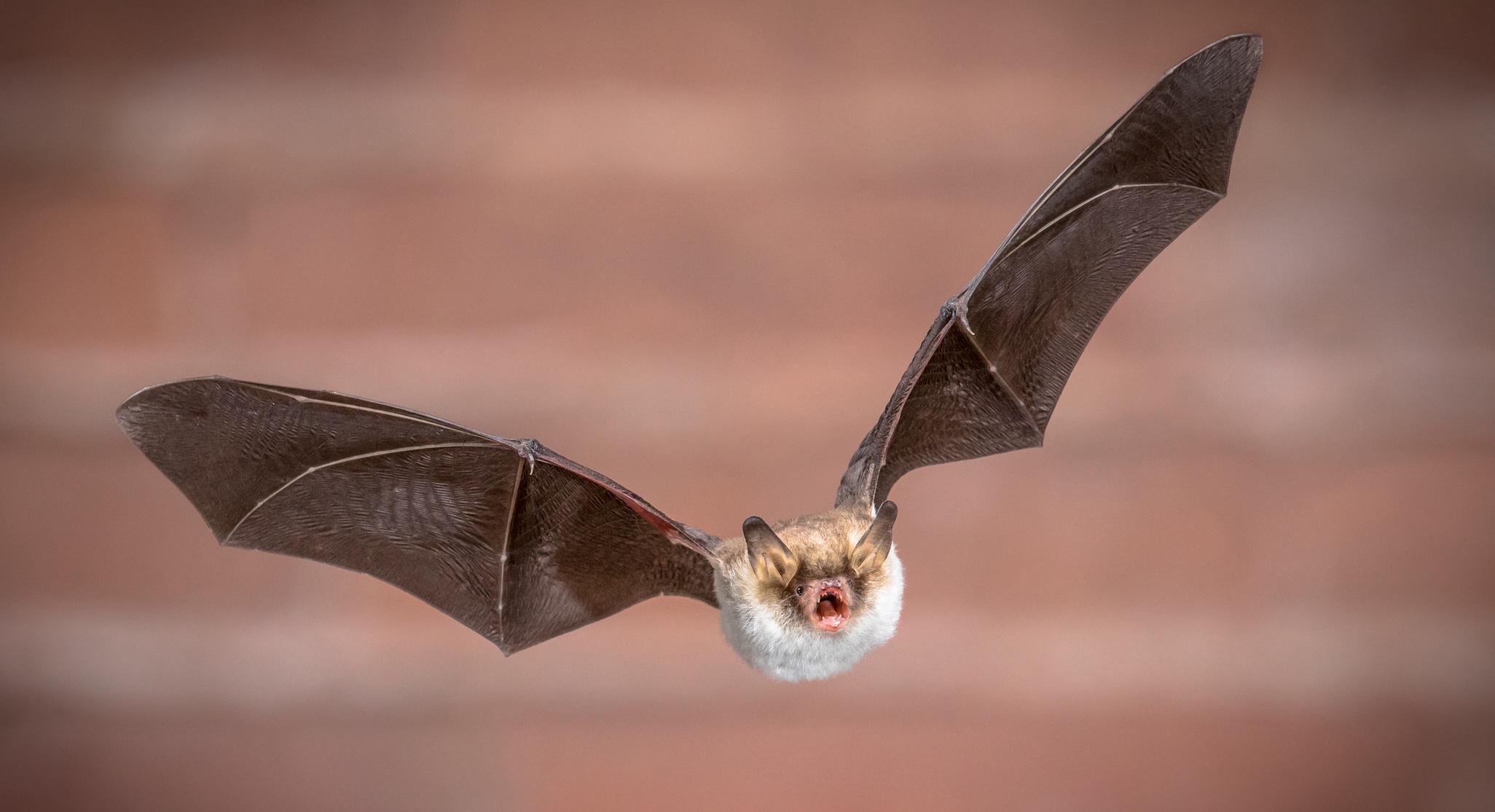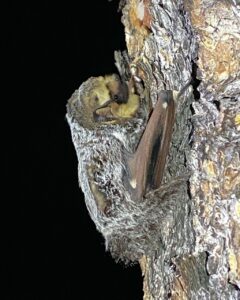
By GARRET JAROS/YachatsNews
SEAL ROCK – The first flicker comes as the sun dips below the horizon and light begins to fade from the sky.
In a seemingly erratic flight that belies an aerodynamic ability beyond birds, every deviation from a straight line in a bat’s flight – whether a tight figure eight or a large lasso-like loop – is only to pluck prey from midair.
Bats are more efficient flyers because of their wings, which are actually modified hands made of soft membrane stretched between thumbs and four elongated fingers so flexible they can fold in half on the upstroke. The Earth’s only flying mammal can reach speeds of 20 to 30 miles an hour and cover more than 100 miles in a night.
Eight of Oregon’s 15 species of bats have small or declining populations, which is one reason wildlife biologists have erected acoustic bat monitoring stations in the Siuslaw National Forest near Table Mountain east of Seal Rock.

Biologists with the Oregon Department of Fish and Wildlife and the U.S. Forest Service began working on the Siuslaw in 2018 to first create openings in the forest and then in 2020 to record which and how many bats visit different habitats.
While state biologists run bat acoustic monitors annually for just a night in certain locations throughout the forest, the Table Mountain site is their first longer-term study and is a flagship project for both agencies.
“We were trying to get more openings for big game – deer, elk, bear and all kinds of other mammals,” said ODFW district wildlife biologist Jason Kirchner. “But they also help birds and bats and so we were like ‘Hey, let’s see what the response is to building these on bats.’ ”
The biologists placed acoustic bat monitors in the meadows, uncleared patches of salmonberry brush and stands of older growth trees. Native pollinating plants like golden rod are also being added to cleared sites via plugs and seeds.
“We are trying to see what types of habitats the bats are using and what species,” Kirchner said. “That’s the main goal. If we create these openings, do we get more bat use, more diversity in bat species?”
Two monitors are placed in each type of habitat to record bat calls from April to November to coincide with warmer and drier weather. Most bats in the area hibernate in the winter when it gets cold and there are less insects, Kirchner said, while others like the Hoary bat migrate south.

Big eaters
Bats are nocturnal animals with keen eyesight and good hearing but it is their use of echolocation that allows some bats to catch a thousand or more small insects in a single hour. A nursing mother eats the most – sometimes catching more than 4,000 insects in a night.
Echolocation is the use of sound waves to determine the location of objects. Bats echolocate by releasing a high-pitched sound from their mouth or nose. Then they listen for the echo to locate prey and navigate.

The monitors have a microphone on top to record the calls, some of which are audible to human ears and others too high pitched to hear. Monitors are set on timers that record from an hour before sunset to an hour after sunrise. The recordings are collected on a memory card and then sent to the Northwestern Bat Hub at OSU-Cascades in Bend for identification.
“With OSU (Oregon State University) they analyze these bat calls and let us know the acoustic machine is working,” Kirchner said. “We’ve got about nine different species of bats so far. It seems like we are getting a lot more diversity in the open meadow right now and a little bit less in the old growth.”
Twelve of Oregon’s 15 species of bats are found west of the Cascade Mountain range and all can be found east of the Cascades. Where each species is found is dependent upon habitat types, vegetation, insect species or size and resting or breeding sites.
The nine species detected thus far by Kirchner and his colleagues are the California myotis, Long-legged myotis, Long-eared myotis, Little brown myotis, Big brown, Silver-haired, Hoary, Fringed myotis and Mexican free-tailed.
Five of the nine – California, Fringed, Long-legged, Silver-haired and Hoary – are Oregon Conservation Strategy species. The conservation strategy identifies 294 species of animals and plants across Oregon with small or declining populations that “are at risk” and a concern for managers, according to ODFW.
Piggybacking in a small way on the Siuslaw forest locations is a much broader baseline study of bats along the coasts of Oregon, Washington and California. The two-year study is funded by the U.S. Department of the Interior’s Bureau of Ocean Energy Management and the U.S. Department of Energy’s wind energy technologies office. It also involves a concerted effort by a bevy of other federal agencies along with the U.S. Coast Guard.
The two-year study, which is just now getting underway after a year of planning, involves installing 36 acoustic monitors in California, Oregon and Washington as well as on ocean buoys as far as 40 kilometers offshore. Bats, including the Hoary, have been photographed and reported by fishermen to hunt insects far out to sea.
Jessie Bunkley, who is with Bat Conservation International, is helping to place acoustic monitors for that study. She joined with local wildlife officials early this month to erect a monitor on one of its Siuslaw sites. She also installed one at Yaquina Head.
“We want to get a baseline understanding of activity by bats along the coastline and offshore prior to putting in wind energy,” said Bunkley, who added that one of the challenges is the lack of data about offshore activity. Four land-based monitors have been installed in Oregon so far and one in southern Washington.
Threats to bats
There are a number of threats facing Oregon’s bat populations including changing climate and habit loss, wind energy development, domestic cats, pesticides and white nose syndrome.

The syndrome, which gets its name from a white fuzz on bats’ faces, is caused by a fungal skin infection and has killed millions of bats in North America. It thrives in cold, dark and damp places. It attacks wing membranes and bare skin. The irritating skin infection can disrupt hibernation, deplete fat storage, and cause dehydration and electrolyte imbalance, leading to death.
The disease originated in Europe and was first observed in New York state in 2006. It quickly spread south and west to 28 states and five Canadian provinces, and was first confirmed in Washington in 2016. Both Washington and Idaho are conducting vaccine trials to curtail the fungus and the impact of the disease. White nose has not been detected in Oregon but is presumed to be in California.
Wind energy is another factor in bat deaths. Hoary bats are the species most frequently found dead at wind power facilities, according to a study released in 2019 by the Bat Hub. The deaths are caused by both collision with the turbines blades as well as barotrauma, which refers to injuries caused by rapid changes in atmospheric pressure around the blades.
“Examination of dead bats collected near turbines often reveal signs of the internal hemorrhaging associated with barotrauma rather than collision,” the study said. The study’s lead author called the rate of hoary bat decline “worrisome” and if it persists represents a “major threat” to the species in the region.
Pesticides also harm bats. They weaken the animal’s immune systems, which make them more susceptible to disease. Consumption of large amounts of pesticide-contaminated insects also results in pesticides stored in bats’ fat, which when metabolized can send toxic concentrations to their brains
Recent studies suggest several non-target organisms, from bees to mammals, show a wide variety of toxic effects of pesticides exposure, including impaired behavior, development and reproduction, according to the National Institutes of Health. Bats are exposed to environmental pollutants through food or water contamination and through direct skin contact in their roosting areas.
Benefit of bats
Bats provide essential pollination, seed dispersal and pest control.
A bat can eat its body weight in mosquitos and other insects in a single night. That decreases threats to people, pets and livestock. A recent study analyzing the agricultural benefit of bats found they provide billions of dollars in value to U.S. agriculture each year because of decreased damage and decreased use of pesticides, according to Oregon State Extension Service.
Most people associate pollination with bees and birds but often forget the work of their furry bat colleagues.
As pollinators, bats are finicky eaters with a specific palate. They tend to enjoy a flower that is mild in scent and not bright in color. Simply speaking, white or pale crop flowers attract the night pollinators to feed on them. Bats get pollen on their faces and bodies before moving on which is how cross pollination happens.
Bats also feed on the flowers of valuable commercial crops, like figs, dates, mangoes and peaches, which have flowers that only open at night.
How to help
Building a bat box for roosting bats is one way to engage in bat conservation. Bat friendly gardens, which means no pesticides, are also a good way to attract insects that bats eat. Native plants and trees that match the region and site conditions are best because they attract native insects.
Bats eat night flying insects, so it helps to plant flowers that either stay open through the night or bloom through the evening. Flowers that are fragrant and herbs such as rosemary, lemon balm or chives also attract moths and other nighttime pollinators.
Leave dead trees standing because bats will use exfoliating barks, cracks and crevices of those dead trees as roosting structures.
Collecting information through acoustic monitoring is a “hands off approach” to studying bats, Kirchner explained. The plan for now is to continue the long-term study using the monitors in specific habitat types for at least another two or three years.
Biologists will keep a close eye on the bats on the conservation strategy list, said Kirchner, who added the most interesting thing to him so far is “how many bats we actually have in the forest. The diversity is pretty cool.”
- Garret Jaros is YachatsNews’ full-time reporter and can be reached at GJaros@YachatsNews.com



We are spending money on things like bats, while the homeless numbers increase every year. I guess we know where government priorities are.